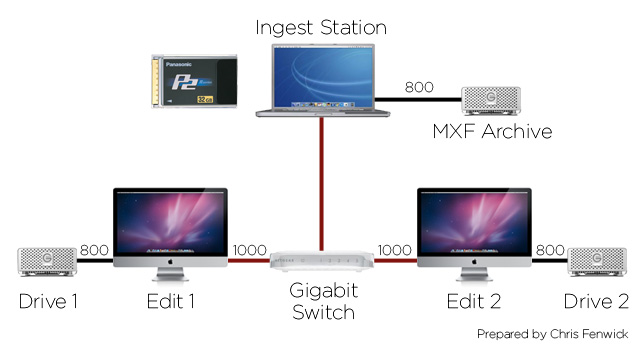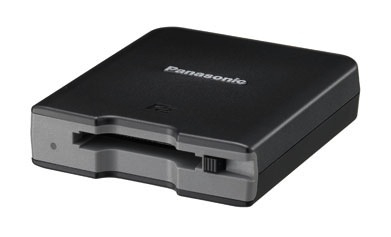Fastest Log and Transfer - My favorite P2 Card Reader
 Thursday, December 3, 2009 at 7:21PM
Thursday, December 3, 2009 at 7:21PM Like many of us for the past couple of years most of my work has been moving to a tapeless nature. I use to say "Friends don't let friends EDIT tape", these days I say, "Friends don't let friends SHOOT tape".
In the San Francisco Bay Area P2 is a pretty dominate format, there are many Panasonic HDX 900's around and a lot of guys use the HVX-200 and with the totally tapess HVX-170, we really are beginning to see the end of tape as a production medium.
Now we just have to deal with the data and there is clearly a lack of good options when it comes to good P2 Readers.
First the bad options...
Horrible option number 1, and I DO MEAN horrible the Duel Adapter. This thing is an express card slot adapter that slides into a MacBook Pro with an express card slot and it has a dongle that hangs out of the computer that is on a cable that is CLEARLY too stiff and the dumb thing doesn't work for me more then half the time. More often then not, to get data from the card I ditch the thing and just put the camera on the desk and use it as a reader thru firewire 400... I basically refuse to use them. (I won't EVEN go into all the times it causes the whole system to go down, I mean full fledged kernal panics... ARG!!!!
Good Option but Costy??? the Panasonic AJ-PCD20. OK so, this is a great device but...
1. Costy, nearly $2,000
2. You have to plug it in to the wall. Not bus powered.
As it turns out this is not a trivial task to make a bus powered P2 reader, that is why no one has done it yet. The PCD20 is pretty fast because its FW-800 but you have to carry it around with a computer to do your tranfers... and its not to small either. Don't get me wrong it's not like carrying a desktop around (there ARE people that put P2 readers in desktop machines but thats not practical to carry in the field.
So what is MY choice? This past week I tried something new (to me) and LOVED it. As it turns out you just have to go back in time a bit. Check Craigslist and pick yourself up an older Powerbook G4. Yea, it has to be an aluminum one and what you'll find is that,
1. It has a PCMCIA card slot
2. It has FW800 and...
3. It has gigabit ethernet.
PCMCIA, the worst acronym in the history of the computer industry. I'm not sure but I think it means "People Can't Remember Computer Industry Acronyms"... I could be wrong. As it turns out, the PCMCIA slot IS a P2 Slot. You'll have to go get yourself a driver to read the card. You should be able to find it here.
Once you have the driver all you have to do is put the card in the PCMCIA slot on the old PowerBook and then you can copy your contents off the card to a small pocket FW800 drive of your choice and create a folder called something like "Card 1" and copy the ENTIRE CONTENTS of the card into that folder on your external drive. its important to use a bus powered drive that way when the electric department pulls your power you aren't HOSED.
My choice for drives are either the G-Tech G-Raid Mini or the Lacie Rugged orange things. The G-Tech has a slight advantage because it has a second FW800 port for looping drives but the PowerBook FW port probably won't supply enough voltage to run both drives reliably.

At this point this post is over. But I want to go into some more details about why this machine is a confluence of good features.
Gigabit Ethernet and File Transfers
Here's what we know. A LOT of people do video editing off of FW800 drives... all the time. Often times there is a need to transfer files, large files and sometimes a LOT of them via FW800 from one drive to another. Take a look at the typical file transfer setup.

For the sake of this graphic I've used our new favorite Late 2003 PowerBook, I am not advocating the use of this computer for anything BUT the transfer of the data. It does not have the "giddy-up" to actually play most of these files well.
If you need to transfer data from one drive to the other we often think that because they are connected via FW800 that the transfer rate will be... uh, 800 "something or others". What we fail to realize is that when data goes from one drive to the other it actually has to first go across the mother board in the CPU. So assuming you are copying data between Drive 1 to Drive 2 the Data has half of the FW800 bandwidth to go from Drive 1 to the Computer, then half of the connection between the Computer to Drive 1 and all of the bandwidth between drive 1 and Drive 2. However, since the connection is only as good as the weakest link the effective speed is half of FW800 or roughly equal to FW400. Ouch… that sucks.

So if you want to move data FAST, this is a much better setup. Use two computers and wire a gigabit switch between them. To move data between Drive 1 and Drive 2 we have the full FW800 bandwidth to computer 1, we have a gigabit connection between Computer 1 and Computer 2 and we have the full FW800 connection to Drive 2. No data has to move on any one cable in BOTH directions. Quite literally, if you do this experiment yourself you will see your data transfer rates be TWICE as fast.
Gigabit Ethernet and Video Production
So now lets take this one step further and build a multi station edit system. Because our trusty 2003 Powerbook came with gigabit ethernet we can use it as our main ingest station and both edit systems can actually transcode the raw MXF data from the media that is stored on the MXF Archive drive.

After doing some experiments I found that doing my Log and Transfer in FCP across this network actually went about 25% faster than if the MXF data was stored on the same drive that I was using as my Capture Scratch in FCP. There is also an added benefit in that, because of the way you've setup your stuff… you will automatically have two copies of your data on two different drives, at the end of the day. One in its RAW MXF form and one as MOV files in your Capture Scratch. Thats COOL.
 UPDATE:
UPDATE:
Panasonic just released the AJ-PCD2. Its a bus powered P2 card reader that uses USB2. Not sure how fast it is but by my estimations the PowerBook and gigabit ethernet method above should be faster.
Looks like it will be out in April and go for about $350. I bet you can get a used PowerBook on Craigslist for that.
 System Design in
System Design in  5DMK2,
5DMK2,  Final Cut Pro,
Final Cut Pro,  Fun,
Fun,  Television
Television 
Reader Comments (4)
YOu are insane!
Using Finder for the copy process is the weak link. It too is fraught with problems with no data integrity check. Better to use a professional copy utility like ShotPutPro http://www.imagineproducts.com . It's faster and verifies each file. Unlike Finder, this app reads the card only once no matter how many copies you're making. And if you use a 5-card reader, it will start copying multiple files from all 5 cards at the same time! Worth every penny.
PS: if you don't think you need file verification, that's true. You can also walk around with a loaded gun in your pants--you probably won't get hurt everytime, but the one time it goes off it's gonna hurt like hell.
Dan, The FUD, (Fear Uncertainty and Doubt) that you preach makes perfect sense, because there are many people that are being thrown into the IT side of video production who don't know what they are doing and, frankly, are afraid of the Finder. And obviously you work for, or own, or at least profit from the sales of Shot Put Pro so you want to perpetuate that FUD... I get it.
I've managed over 100TB of digital data, not a lot I know but nothing to sneeze at, over the past several years, and NEVER lost a file. EVER.
A bigger issue with file transfer then the 'mystery loss' you preach is loosing power during a copy. THAT should be feared and THAT is why I encourage people to set up a system that is inherently backed up by the battery in the laptop and bus powered drives.
The 5 card reader needs AC, not cool. Of course, so does the gigabit switch in the system I describe above so what the hell do I know.